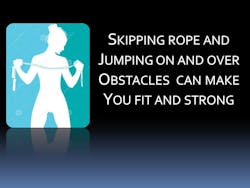If you’re like me you’re always looking for a way to switch up your fitness routine. Maybe you’ve become board with your present workout, or perhaps an injury has caused you to vary what you’ve been doing. Or you’re at a sticking point and haven’t made any improvements or gains. Whatever the reason, I’d like you to consider a routine that consists of jumping rope and plyometrics. Both burn more calories than you might think.
Let’s begin with jumping rope - it’s a great calorie burner compared to running an eight-minute mile. In addition to burning a lot of calories, jumping rope strengthens both the upper and lower body. Moreover, if done properly, it’s a lower-impact activity than jogging. The exercise seems simple enough, but if you haven’t jumped rope in a while it can be both embarrassing and humbling since it requires coordination.
Rather than trying to jump for a specific length of time, such as five minutes, jump in intervals of perhaps 50-200 repetitions, rest in between sets. Stay high on your toes, only come one inch off the floor. Jumping any higher makes it more of a high impact activity. Try to jump for a total of ten minutes with rest intervals. You’ll quickly discover this exercise is one that will get you sweating as your heart rate increases. As a reminder, determining your maximal heart rate formula is 220 minus your age. The high end of your target zone is 85% of that number.
Don’t have a jump rope? A good one with foam handles and PVC cable can be purchased for under ten dollars at sporting goods stores. It’s best not to jump on carpet, grass, concrete or asphalt. Use an impact mat made for exercise, a wood floor, or a piece of plywood. Jumping rope will improve your cardiovascular health, your agility, and coordination. The best part? It’s also fun.
Speaking of fun, remember your childhood when you used to go crazy on the playground? Running, jumping, and hopping around? Those were all activities that helped you gain strength, fitness, and confidence. As an adult you can achieve the same results with plyometrics. People commonly refer to plyometrics as jump training, and it’s often used by athletes to train for basketball, volleyball, and football.
Plyometrics is a fun alternative to everyday strength training. It boosts your muscle power, strength, balance, and agility. Since plyo (as it’s sometimes called) is a high intensity workout, it can’t be done on a daily basis. The moves are quick and explosive and require a lot more energy than a typical strength training session. Specifically, plyo movements target the legs and glutes, and increase your flexibility because your muscles contract and stretch.
If you’ve never done plyometrics, start simply by jumping up on a box, bench, or other platform. As your proficiency increases, you can raise the height of the object you’re jumping on or over. You can also use stairs or choose to jump over cones. I’ve sometimes used a rope ladder on the ground and I leap forward as far as I can. Although not considered an aerobic workout, if you do repeats for 30-60 seconds at a time your heart rate will definitely increase.
Plyometrics is ideal for anyone looking to improve muscular power, speed, and strength, and may also help facilitate weight loss. It is not a low impact exercise so it may cause some stress on the joints. Start slowly to test your agility, coordination, and strength. Since it is an advanced exercise, begin slowly and only perform plyo once or twice per week on nonconsecutive days. Jumping rope first is a great warm up that increases blood flow to your muscles and helps prevent injury.
I’ve created a short video of my training partner, Edwin Cruz, who demonstrates both jumping rope and plyometrics (box jumping).
Stay fit, Brothers and Sisters!
About the Author
John Wills
John M. Wills is a former Chicago police officer and retired FBI agent. He is a freelance writer and award-winning author in a variety of genres, including novels, short stories and poetry. John also writes book reviews for the New York Journal of Books, and is a member of the National Book Critics Circle. His new book, The Year Without Christmas, is available now. Visit John at: www.johnmwills.com.

